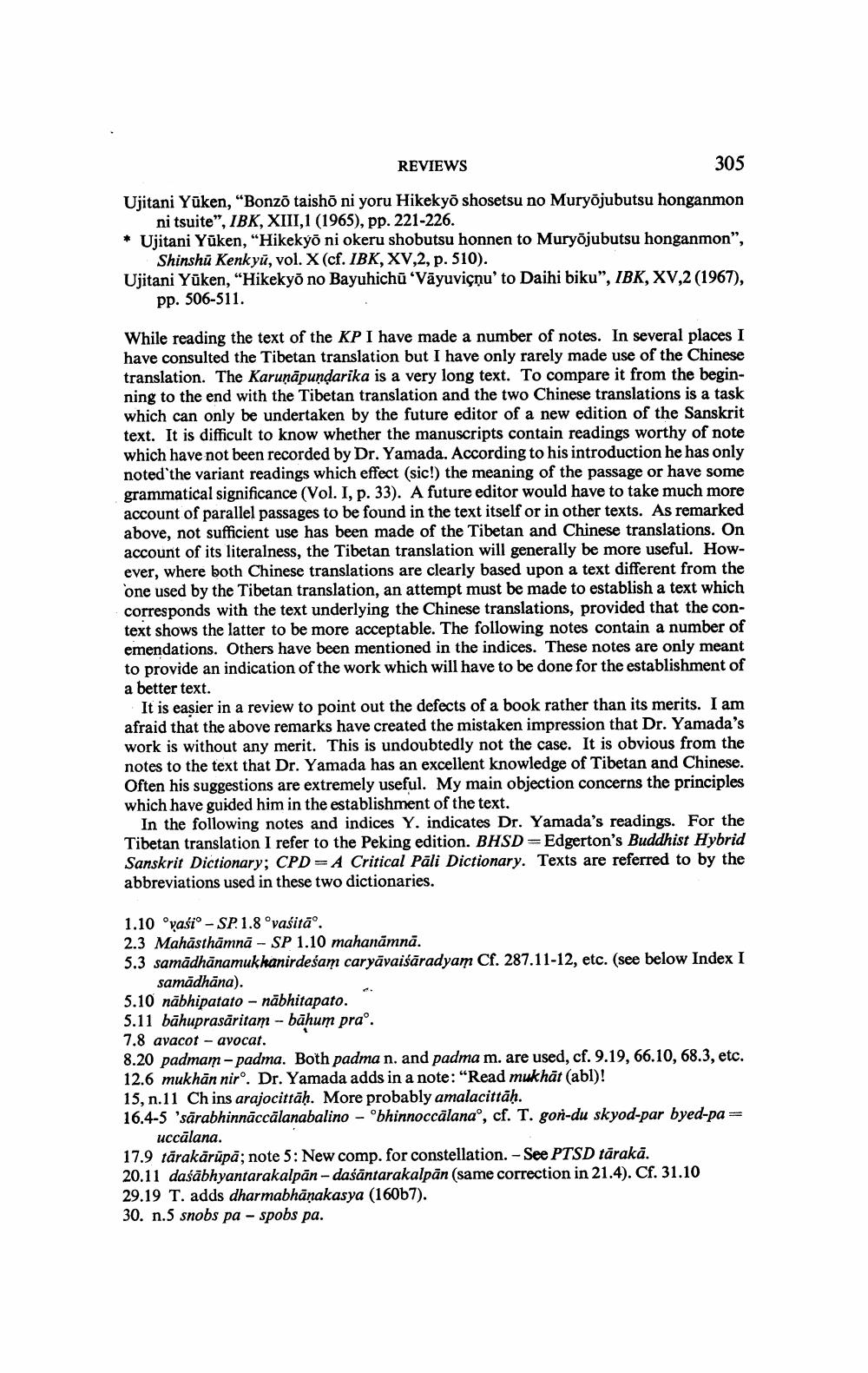Book Title: Reviews Of Different Books Author(s): Publisher: View full book textPage 9
________________ REVIEWS 305 Ujitani Yuken, "Bonzo taisho ni yoru Hikekyo shosetsu no Muryojubutsu honganmon ni tsuite", IBK, XIII, 1 (1965), pp. 221-226. * Ujitani Yuken, "Hikekyo ni okeru shobutsu honnen to Muryojubutsu honganmon", Shinshu Kenkyu, vol. X (cf. IBK, XV,2, p. 510). Ujitani Yuken, "Hikekyo no Bayuhichu Vayuvicnu' to Daihi biku", IBK, XV,2 (1967), pp. 506-511. While reading the text of the KP I have made a number of notes. In several places I have consulted the Tibetan translation but I have only rarely made use of the Chinese translation. The Karunapundarika is a very long text. To compare it from the beginning to the end with the Tibetan translation and the two Chinese translations is a task which can only be undertaken by the future editor of a new edition of the Sanskrit text. It is difficult to know whether the manuscripts contain readings worthy of note which have not been recorded by Dr. Yamada. According to his introduction he has only noted the variant readings which effect (sic!) the meaning of the passage or have some grammatical significance (Vol. I, p. 33). A future editor would have to take much more account of parallel passages to be found in the text itself or in other texts. As remarked above, not sufficient use has been made of the Tibetan and Chinese translations. On account of its literalness, the Tibetan translation will generally be more useful. However, where both Chinese translations are clearly based upon a text different from the one used by the Tibetan translation, an attempt must be made to establish a text which corresponds with the text underlying the Chinese translations, provided that the context shows the latter to be more acceptable. The following notes contain a number of emendations. Others have been mentioned in the indices. These notes are only meant to provide an indication of the work which will have to be done for the establishment of a better text. It is easier in a review to point out the defects of a book rather than its merits. I am afraid that the above remarks have created the mistaken impression that Dr. Yamada's work is without any merit. This is undoubtedly not the case. It is obvious from the notes to the text that Dr. Yamada has an excellent knowledge of Tibetan and Chinese. Often his suggestions are extremely useful. My main objection concerns the principles which have guided him in the establishment of the text. In the following notes and indices Y. indicates Dr. Yamada's readings. For the Tibetan translation I refer to the Peking edition. BHSD=Edgerton's Buddhist Hybrid Sanskrit Dictionary; CPD=A Critical Pali Dictionary. Texts are referred to by the abbreviations used in these two dictionaries. 1.10 degyasio - SP 1.8 degvasitadeg. 2.3 Mahasthamna - SP 1.10 mahanamna. 5.3 samadhanamukhanirdesam caryavaisaradyam Cf. 287.11-12, etc. (see below Index I samadhana). 5.10 nabhipatato - nabhitapato. 5.11 bahuprasaritam - bahum prao. 7.8 avacot - avocat. 8.20 padmam-padma. Both padma n. and padma m. are used, cf. 9.19, 66.10, 68.3, etc. 12.6 mukhan niro. Dr. Yamada adds in a note: "Read mukhat (abl)! 15, n.11 Ch ins arajocittah. More probably amalacittah. 16.4-5 'sārabhinnācсālanabalino - bhinnoccalana", cf. T. gon-du skyod-par byed-pa = uccalana. 17.9 tarakarupa; note 5: New comp. for constellation. - See PTSD taraka. 20.11 dasabhyantarakalpan - dasantarakalpan (same correction in 21.4). Cf. 31.10 29.19 T. adds dharmabhanakasya (160b7). 30. n.5 snobs pa - spobs pa.Page Navigation
1 ... 7 8 9 10 11 12 13 14 15 16 17 18 19 20 21 22 23
